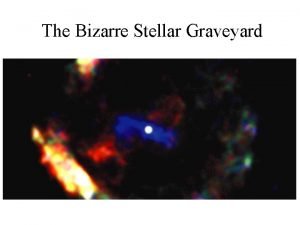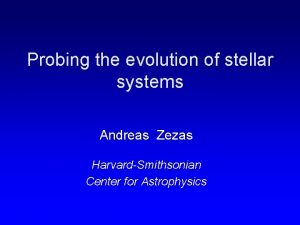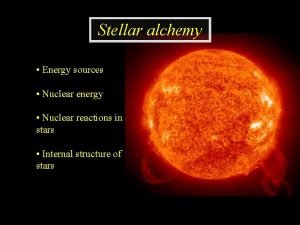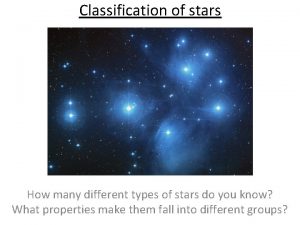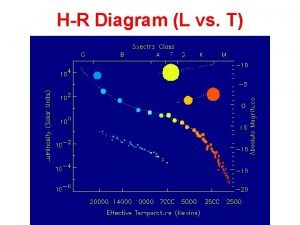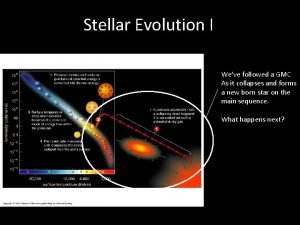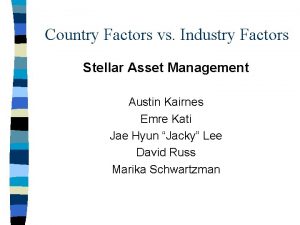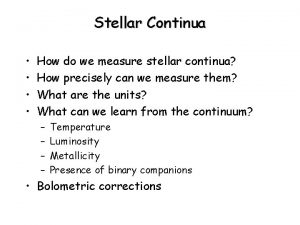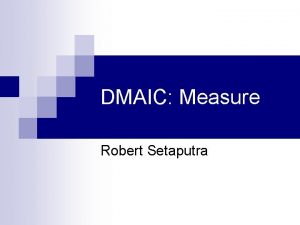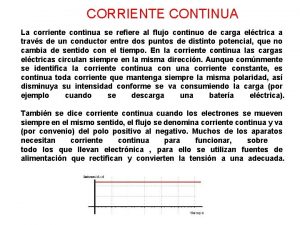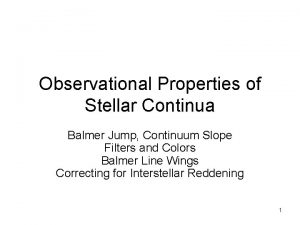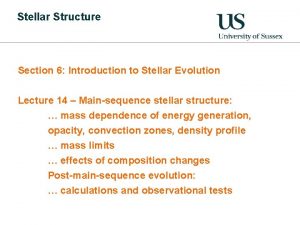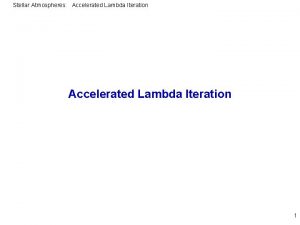Stellar Continua How do we measure stellar continua

















- Slides: 17

Stellar Continua • • How do we measure stellar continua? How precisely can we measure them? What are the units? What can we learn from the continuum? – – Temperature Luminosity Metallicity Presence of binary companions • Bolometric corrections

Measuring Stellar Flux Distributions • Low resolution spectroscopy (R~600 or 50 -100 Å) • Wide spectral coverage • Access to fainter stars (why? ) • Use a large (but not too large) entrance aperture (why? ) • Correct for sky brightness and telluric extinction

Measuring Stellar Flux Distributions • Four steps – Select a standard star (Vega) – Measure the shape of standard star’s energy distribution (relative Fn vs. l) – Measure the standard star’s absolute flux at (at least) one wavelength – Correct for line absorption

Primary Photometric Standards • Vega (A 0 V) • For absolute flux, compare to standard laboratory sources, usually black bodies • Flux measured in ergs cm-2 s-1 A-1 at the top of the Earth’s atmosphere • Often plotted as – – Fl vs. A Fn vs. wavenumber (cm-1 = 1/l in cm) Log Fl + constant vs. A Log Fn + constant vs. wavenumber

Stellar SEDs

Calculating Fl from V • Best estimate for Fl at V=0 at 5556Å is Fl = 3. 36 x 10 -9 erg s-1 cm-2 Å-1 Fl = 996 photon s-1 cm-2 Å-1 Fl = 3. 56 x 10 -12 W m-2 Å-1 • We can convert V magnitude to Fl: Log Fl = -0. 400 V – 8. 449 (erg s-1 cm-2 Å-1) Log Fn = -0. 400 V – 19. 436 (erg s-1 cm-2 Å-1) • To correct from 5556 to 5480 Å: Log [Fl (5556)/Fl(5480)]=-0. 006– 0. 018(B-V)

What about the Sun? • Absolute flux uncertain by about 2% • Mv (~4. 82) uncertain by about 0. 02 mags • B-V even more uncertain • values range from 0. 619 to 0. 686

Practice Problems • Assuming an atmosphere + telescope + spectrograph+ detector efficiency of 10%, how many photons would be detected per Angstrom at 5480 A using a 1. 2 -m telescope to observe a star with V=12 (and B-V=1. 6) for one hour? • Using the CTIO 4 -m telescope, an astronomer obtained 100 photons per A at 5480 A in a one hour exposure. Again assuming an overall efficiency of 10%, what was the magnitude of the star if B-V=0?

Bound Free Continua • Lyman – far UV • Balmer – UV • Paschen – optical • Brackett – IR • Pfund – more IR

Interpreting Stellar Flux Distributions I. The Paschen Continuum • The Paschen continuum slope (B-V) is a good temperature indicator • Varies smoothly with changing temperature • Slope is negative (blue is brighter) for hot stars and positive (visual is brighter) for cooler stars • B-V works as a temperature indicator from 3500 K to 9000 K (but depends on metallicity) • For hotter stars, neutral H and H- opacities diminish, continuum slope dominated by Planck function, and the Rayleigh-Jeans approximation gives little temperature discrimination

The Paschen Continuum vs. Temperature 50, 000 K 4000 K

Interpreting Stellar Flux Distributions II – The Balmer Jump • The Balmer Jump is a measure of the change in the continuum height at 3647 A due to hydrogen bound-free absorption • Measured using U-B photometry • Sensitive to temperature BUT ALSO • Sensitive to pressure or luminosity (at lower gravity, the Balmer jump is bigger – recall that kbf depends on ionization, and hence on Pe) • Works for 5000 < Teff < 10, 000 (where Hbf opacity is significant)

Flux Distributions at T=8000 Log g = 4. 5 Log g = 1. 5

Bolometric Flux • Bolometric flux (Fbol) is the integral of Fn over all wavelengths • Fbol is measured in erg cm-2 s-1 at the Earth • Luminosity includes the surface area (where R is the distance from the source at which Fbol is measured): • L is measured in units of erg s-1, R is distance, r is radius

Bolometric Corrections • Can’t always measure Fbol • Compute bolometric corrections (BC) to correct measured flux (usually in the V band) to the total flux • BC is usually defined in magnitude units: BC = m. V – mbol = Mv - Mbol

Bolometric Corrections from AQ

Class Problem • A binary system is comprised of an F 0 V star (B-V=0. 30) and a G 3 IV star (B-V=0. 72) of equal apparent V magnitude. – Which star has the larger bolometric flux? – What is the difference between the stars in Mbol?
 Measure air temperature and measure air pressure
Measure air temperature and measure air pressure Gibbons jacobean city comedy download
Gibbons jacobean city comedy download Stellar graveyard
Stellar graveyard Stellar wifi
Stellar wifi Stellar saga
Stellar saga Stellar
Stellar Stellar evolution diagram
Stellar evolution diagram Stellar nucleosynthesis
Stellar nucleosynthesis Life cycle of stars poster
Life cycle of stars poster Stellar heaven
Stellar heaven Stellar alchemy
Stellar alchemy What is stellar parallax?
What is stellar parallax? Stellar formation
Stellar formation Stellar motion matlab
Stellar motion matlab Stellar evolution
Stellar evolution Iptv hosting
Iptv hosting Mizar luminosity
Mizar luminosity Stellar asset management
Stellar asset management


